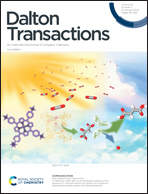Development of thermally stable red-emitting lead-free double-perovskite phosphors with an internal PLQY approaching 100%†
Abstract
White light-emitting diode (WLEDs), acting as a new generation of solid-state lighting, play a critical role in energy conservation. Red-emitting phosphors with high efficiency could effectively improve the quality of WLED devices. In this report, Eu3+-doped Ca2ScTaO6 luminescent materials have been successfully synthesized by a high-temperature solid-state method. Its crystal structure was confirmed to be a monoclinic lead-free double-perovskite material system with the space group P21/n by the X-ray diffraction patterns. The strongest emission peak was about 614 nm distributed to the 5D0 → 7F2 electric-dipole transition. Additionally, the optimal doping concentration was found to be 40 mol%, and the concentration quenching mechanism is assigned to d–d interactions. The Ca2ScTaO6:Eu3+ phosphors exhibited an ultrahigh internal quantum yield (about 100%) with good thermal stability (81.5% at 423 K compared with the emission intensity at 303 K). Furthermore, a WLED with a suitable correlated color temperature (4201 K) and a color rendering index (87.62) was fabricated. The phosphor-based polydimethylsiloxane light-emitting flexible film exhibited good luminescence, which is suitable to be utilized in flexible displays. The obtained results suggest that the high-efficiency red-emitting Ca2ScTaO6:Eu3+ phosphors are promising commercial candidates for use in near-ultraviolet-excited WLEDs.



 Please wait while we load your content...
Please wait while we load your content...